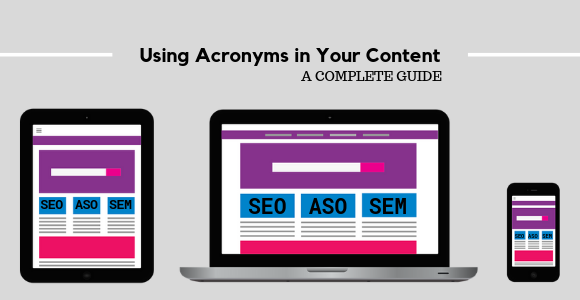BTW, can you plz lmk the news ASAP? Thx! – Now, how much of that did you understand? Even if you got the whole message, was it hard for you to read it at first? Some people are used to abbreviating words or acronyms, in this case. However, there are still some late bloomers and it might not always be appropriate to use them. Today, I will be discussing the importance of using them when necessary, when SEO content writers should include them, and more!
What is an Acronym?
It’s an abbreviation of a word.
To elaborate, an acronym is a word that has been formed as an abbreviation of a longer phrase or even a single word. It usually consists of letters and syllables. My opening sentence to this blog included a few of them: btw, plz, lmk, asap, and thx – or in other (longer) words: by the way, please, let me know, as soon as possible, and thanks.
You may be thinking what the point is, but in some cases, it does make sense. Ideally, it is a time-saving technique to use acronyms because you don’t have to write out the entire word or phrase. In some situations, you are limited to a character count and want to get in more than you can fit – thus, abbreviating using acronyms comes in handy.
With that being said, there are a few rules as to how to correctly and efficiently use acronyms.
Title Names
Recurring names of companies and more.
We all know that there are some company names out there that are way too long. Even if they aren’t so lengthy, it may become redundant for website content writers to continue to spell it all out over and over again.
Some commonly used acronyms for companies include:
- BMW: It stands for Bayerische Motoren Werke in German – translated into English means “Bavarian Motor Works”
- DSW: Designer Shoe Warehouse
- ZIP Code: Zone Improvement Plan Code
- UPS: United Postal Service
- ESPN: Entertainment and Sports Programming Network
There are many more where that came from and you may have never realized how common acronyms are until now! While these are common to most people, you have to keep in mind that throwing in “UPS” in a blog without specifying what it stands for, may confuse the reader if they are not familiar with it.
This leads to one of the most important rules for using acronyms: define the abbreviation before using it.
How?
Use this example: The United Postal Store (UPS), is where you can go to drop off a package.
Be Professional
Leave the Twitter talk on Twitter
The younger generations are abbreviating everything, it sometimes gets out of control. It is important to not confuse or frustrate you readers – which can happen if phrases are shortened to 4 letters or more. Especially, if they are not familiar with the slang.
Know your audience and help them get to know you. If you are active on Twitter, it comes in handy to use acronyms because of the character limit. Just remember to use universal or common acronyms and define them for your audience when needed.
Using Numbers
Make your content easier to read
Oftentimes, SEO content writers may use numbers to make their point. However, using a digit instead of writing out the number for instance “4” instead of “four” can be beneficial. This is because it can be easier for the readers to digest the information, it is shorter to read, and it can be more appealing. The key is to be consistent throughout your content!
Change It Up
Use different kinds of acronyms for your various target markets
If you have a wide target audience, it may come in handy to use some acronyms more often in certain content. For instance, a lot of the millennials or even generation Z’s are very familiar with acronyms. Given that, you can surely go for that KISS (keep it simple stupid) technique!
Different Industry – Different Acronym
Beware.
From one industry to the other, the acronyms may be the same – yet different. Say what?! Yes, it’s true!
- Prob: this generally means “probably”, at least – that is what I use it for. However, it can also mean (depending on the industry) probability or maybe even probiotics.
- CPA: this is either a Certified Public Accountant or it could mean “cost per action” in marketing.
- UV: can mean ultraviolet lights or “unique visitor” for a website (which is what you want for your website, btw) → see what I did there? I used an acronym but made sure that you knew what it meant first.
Conclusion
Alright, so you pretty much have a basic guide as to how and when to use acronyms. Hopefully, you learned something new. All website content writers could use a refresher on topics like these. Now you can implement acronyms in your website content effectively. LMK how you use acronyms in your content!







